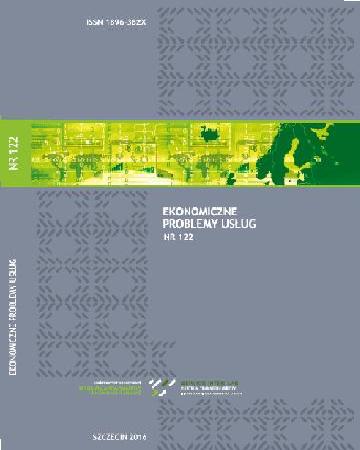
ISSN: 1896-382X
eISSN: 2353-2866
OAI
DOI: 10.18276/epu.2018.131/2-13



Lista wydań /
nr 131 (2) 2018
Approach to exploring users’ expectations of digital services’ functionality
(PRÓBA ZBADANIA OCZEKIWAŃ UŻYTKOWNIKÓW WOBEC FUNKCJONALNOŚCI USŁUG CYFROWYCH)
| Autorzy: |
Radka
Nacheva
University of Economics – Varna, Bulgaria Faculty of Computer Sciences Informatics Department Snezhana Sulova University of Economics – Varna |
| Słowa kluczowe: | oczekiwania użytkownika usługi cyfrowe e-commerce eksploracja tekstu strategia UX |
| Data publikacji całości: | 2018-05-12 |
| Liczba stron: | 9 (137-145) |
| Klasyfikacja JEL: | C83 C88 |
Abstrakt
Pod względem szybkiej adaptacji technologii w życiu codziennym, zwiększonej konkurencji między przedsiębiorstwami i ciągłych zmian preferencji klientów, firmy poszukują nowych sposobów zwiększenia udziału w rynku i podniesienia lojalności konsumentów. Niezbędna jest nowa strategia obsługi klienta, a mianowicie zastosowanie zasad projektowania aplikacji zorientowanych na użytkownika. Głównym celem artykułu jest zaproponowanie i zatwierdzenie opartego na ankietach podejścia do badania oczekiwań użytkowników odnośnie do funkcjonalności usług cyfrowych.
Pobierz plik
Plik artykułu
Bibliografia
| 1. | Amin, Sh. (2017). UX Strategy and Creating Successful Products. Retrieved from: https://uxplanet.org/ux-strategy-and-creating-successful-products-9de855ab56da (4.01.2018). |
| 2. | Baty, St. (2009). What is an Experience Strategy? Retrieved from: http://johnnyholland.org/ 2009/06/what-is-an-experience-strategy/ (3.01.2018). |
| 3. | Baxter, K., Courage, C., Caine, K. (2015). Understanding Your Users: A Practical Guide to User Research Methods. Burlington: Morgan Kaufmann Publishers. |
| 4. | Chen, Z., Zhu, S. (2011). The research of mobile application user experience and assessment model. Proceedings of 2011 International Conference on Computer Science and Network Technology (p. 2832–2835). |
| 5. | Consolvo, S. et. al. (2017). Mobile User Research: A Practical Guide. San Rafael: Morgan & Claypool. |
| 6. | Goldkuhl, G., Röstlinger, A. (2010). Development of public e-services - a method outline. Retrieved from: http://www.vits.org/publikationer/dokument/722.pdf (4.01.2018). |
| 7. | Goodman, E. et. al. (2012). Observing the User Experience, Second Edition: A Practitioner's Guide to User Research. Burlington: Morgan Kaufmann Publishers. |
| 8. | Holgersson, J. (2014). User Participation in Public E-Service Development (Doctoral dissertation). Retrieved from: http://his.diva-portal.org/smash/get/diva2:760905/FULLTEXT01.pdf. |
| 9. | Kannan, P.K. (2013). Designing and Pricing Digital Content Products and Services: A Research Review. Review of Marketing Research (p. 97–114). Emerald Group Publishing. |
| 10. | Lang, J., Howell, E. (2017). Researching UX: User Research. SitePoint. |
| 11. | Levy, J. (2003). UX Strategy: How to Devise Innovative Digital Products that People Want. Sebastopol: O'Reilly Media, Inc. |
| 12. | Loo, T. (2017). What is user experience strategy? Retrieved from: http://www.foolproof.co.uk/ thinking/what-is-user-experience-strategy/ (3.01.2018). |
| 13. | Miller, R. et. al. (2008). Information Systems Service Quality: An Examination of User Expectations. American Journal of Business, 2 (23), 37–42. |
| 14. | Monahan, K. et. al. (2008). An investigation into the use of field methods in the design and evaluation of interactive systems. Proceedings of the 22nd British HCI Group Annual Conference on People and Computers: Culture, Creativity, Interaction (BCS-HCI '08). Vol. 1 (pp. 99–108). Swinton: British Computer Society. |
| 15. | Nunnally, B., Farkas, D. (2016). UX Research. Sebastopol: O′Reilly. |
| 16. | Pagano, D., Bruegge, B. (2013). User involvement in software evolution practice: A case study. 35th International Conference on Software Engineering (ICSE) (pp. 953–962). San Francisco. |
| 17. | Roman, D. et. al. (2005). Web Service Modeling Ontology. Journal Applied Ontology, 1 (1), 77–106. |
| 18. | Sauro, J., Lewis, J. (2016). Quantifying the User Experience, Second Edition: Practical Statistics for User Research. Burlington: Morgan Kaufmann Publishers. |
| 19. | Silva, P.A., Read, J.C. (2010). A methodology to evaluate creative design methods: a study with the BadIdeas method. Proceedings of the 22nd Conference of the Computer-Human Interaction Special Interest Group of Australia on Computer-Human Interaction (OZCHI '10) (pp. 264–271). New York: ACM. |
| 20. | Walker, J., Baker, J. (2000). An exploratory study of a multi‐expectation framework for services. Journal of Services Marketing, 5 (14), 411–431. |